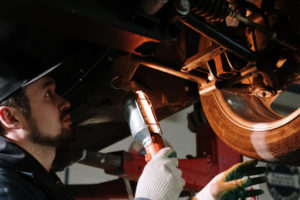There are four types of drivetrains that a vehicle can have: front, rear, 4-wheel, and all wheel. Each type has its own set of benefits and drawbacks that may be all the difference in what you decide to purchase, depending on your driving habits. Here, we discuss the difference between drive types and the pros and cons of each.
The difference between drive types
Put simply, your engine’s drivetrain is a system that connects your car’s transmission to its axles, delivering engine power to the wheels. The terms ‘front’, ‘rear’, ‘4-wheel’, and ‘all-wheel’ refer to which wheels are receiving the power.
Front
 Most cars on the road these days are front-wheel drive vehicles. This type of car features a drivetrain that powers the two wheels at the front of the vehicle. There are several benefits of this type of drive train, including:
Most cars on the road these days are front-wheel drive vehicles. This type of car features a drivetrain that powers the two wheels at the front of the vehicle. There are several benefits of this type of drive train, including:
- Fuel efficiency: The drive axles in a front-wheel drive vehicle are shorter than their siblings since they don’t need to connect to the rear of the vehicle. This makes for lighter weight vehicles and fewer trips to the gas station.
- Less costly: This type of drive is less complicated compared to others and is less expensive to produce for manufacturers. It’s also less expensive for consumers to maintain over the life of the vehicle.
- Performs well in many types of weather: Front-wheel drive vehicles maintain good traction on wet surfaces, snow, sand, gravel, and more. This type of drive also reduces the likelihood of your vehicle ‘fishtailing’, a problem that is more common in rear-wheel drive cars.
Despite these advantages, there are several drawbacks to a front-wheel drive vehicle.
- Torque steer can cause the car to pull to one side or the other when accelerating quickly.
- The vehicle’s turning radius is much larger than other types of drives because there isn’t as much room under the front of the vehicle.
- Your front tires may wear out faster than other types of drives since they are carrying the combined weight of the engine, transmission, and drivetrain, and also have to absorb everyday braking, acceleration, and steering.
- Front-wheel drive systems may not last as long as other types of drives.
Rear
 In a rear-wheel drive vehicle, the engine is positioned at the front of the vehicle and provides power to the wheels at the back of the car or truck. There are several benefits to a rear-wheel drive vehicle, including:
In a rear-wheel drive vehicle, the engine is positioned at the front of the vehicle and provides power to the wheels at the back of the car or truck. There are several benefits to a rear-wheel drive vehicle, including:
- Excellent acceleration from a standstill: Rear-wheel drive vehicles are not impacted by torque steer like their front-wheel drive siblings, offering superior handling when accelerating from a complete stop. This aspect makes rear-wheel drive vehicles the drive of choice for performance vehicles.
- Better turning radius: Because the vehicle’s drive wheels are in the back and do not have to share space with the engine and front suspension, they can turn more sharply than front-wheel drive cars.
- Better payload capacity: Extra weight over the rear wheels increases the towing capacity of the vehicle, which is ideal for pickup trucks.
There are some drawbacks to consider when it comes to rear-wheel drive vehicles.
- These vehicles do not perform as well in inclement conditions, especially snow, as they are more likely to get stuck. They are also more likely to fishtail on wet surfaces.
- They are not as fuel efficient as front-wheel drive vehicles.
4-wheel
 As the name suggests, 4-wheel drive (4WD) vehicles feature a drivetrain that is designed to deliver power to all four wheels. The vehicle may be designed to have a full or part-time system; part-time offers the additional choice for the driver to switch between rear and 4WD depending on their needs. There are several advantages of 4WD vehicles, including:
As the name suggests, 4-wheel drive (4WD) vehicles feature a drivetrain that is designed to deliver power to all four wheels. The vehicle may be designed to have a full or part-time system; part-time offers the additional choice for the driver to switch between rear and 4WD depending on their needs. There are several advantages of 4WD vehicles, including:
- Superior off-road capability: These vehicles are unmatched in off-road conditions.
- Superior towing capacity: 4WD vehicles are equipped with heavy-duty suspensions that are ideal for towing, whether on or off-road.
- Superior performance in inclement weather: 4WD vehicles are excellent in all types of driving conditions, especially snowy and wet conditions.
That said, there are several disadvantages to consider about 4WD vehicles.
- The weight of the vehicle decreases fuel economy.
- 4WD vehicles require more frequent service than two-wheel drive vehicles due to the number of components in the vehicle.
- 4WD vehicles are more costly than two-wheel drive cars.
All wheel
 Although all-wheel and 4-wheel drive types may sound like different terms for the same thing, they work a little differently and are distinct enough to be considered their own category.
Although all-wheel and 4-wheel drive types may sound like different terms for the same thing, they work a little differently and are distinct enough to be considered their own category.
All-wheel drive (AWD) vehicles work with the onboard computer to continuously transfer power between the wheels depending on where it’s needed most, whether that’s accelerating quickly or in response to wet or snowy conditions. There are several advantages to AWD vehicles, including:
- Excellent performance in inclement weather: Since power is being directed where it’s needed most, AWD vehicles offer great performance in poor driving conditions.
- Versatile: AWD vehicles perform equally well off-road as they do on city streets, which is ideal for drivers who regularly do both types of driving.
There are some drawbacks to consider, though, about AWD cars.
- Like 4WD vehicles, AWD cars are heavier and require more fuel to operate.
- AWD vehicles may require more frequent service than two-wheel drive cars.
- AWD vehicles are more costly than front or rear-wheel drive vehicles.
Drivetrain Repair And More At T3 Atlanta
Whether you need work on your vehicle’s drivetrain or want to get preventive maintenance to keep your car in top shape, T3 Atlanta is here and ready to provide the service your vehicle deserves. Give us a call at our convenient Smyrna or Decatur location and we’ll book you in for fast and friendly service today.










Leave a Reply
You must be logged in to post a comment.